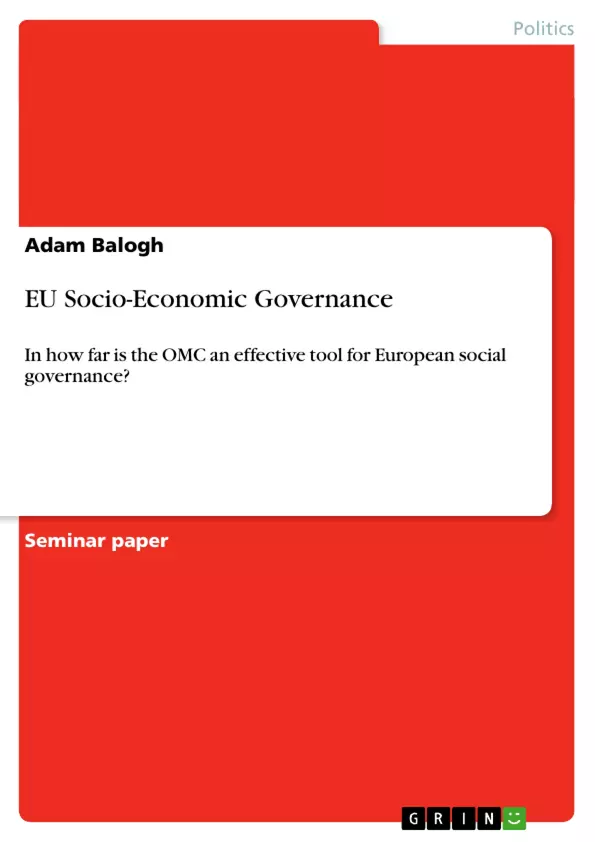In the mid-1990s, welfare states in Europe were under acute strain. Unemployment had risen dramatically (Trubek/Mosher 2001, 6) and in 1997, 18 per cent of the population of the European Union (EU) lived in a household below the relative income poverty threshold (Armstrong 2010, 1). Although social policies were traditionally tasks of the nation-states, an increasing “Europeanization” of “social exclusion” and the inability of the member states to act in an increasing multi-level governance context led to the need for actions on a European level (Armstrong 2010, 2).
The start was made with the “European Employment Strategy” (EES) (Trubek/Mosher 2001, 6), which became, due to its success, (Trubek/Trubek 2005, 349-351) the forerunner of the “Open Method of Coordination” (OMC) (Sabel/Zeitlin 2008, 289). The OMC, like the EES, is an Instrument of governance in the EU, which is based on voluntary cooperation and rests on soft law mechanism (Borrás/Jacobsson 2004, 189). Armstrong describes the function of the OMC in his Book about European policy coordination as follows: “The function of the OMC is not to make policy itself but rather to provide a framework within which states are encouraged to identify policy problems and to seek solutions either within their own domestic systems or by learning from the experience of others” (Armstrong 2010, 9). The reason for this soft law solution was the lack of political support for further transfers of legal competencies to the EU in social areas (Borrás/Jacobsson 2004, 190). But precisely because of this soft law nature, many critics accuse that the OMC is ineffective and even dangerous for further European integration (Trubek/Trubek 2005, 344, 351, 355).
Inhaltsverzeichnis (Table of Contents)
- Introduction
- The Open Method of Coordination
- The Evaluation of the Open Method of Coordination
- Policy Recommendations
- Bibliography
Zielsetzung und Themenschwerpunkte (Objectives and Key Themes)
This term paper aims to investigate the effectiveness of the Open Method of Coordination (OMC) as a tool for European social governance. It seeks to determine if the OMC is a viable instrument for addressing social issues within the European Union, particularly in light of rising unemployment and poverty following the European sovereign debt crisis. The paper will explore the history, principles, and impacts of the OMC, providing a detailed evaluation and concluding with policy recommendations.
- The emergence and development of the OMC as a tool for European social governance
- The principles and mechanisms of the OMC, including its emphasis on soft law and voluntary cooperation
- The effectiveness of the OMC in achieving its objectives, considering its limitations and challenges
- The potential for alternative policies to address European socioeconomic problems, particularly in the context of increasing unemployment and poverty
- The role of the OMC in European integration and its impact on the balance of power between national and EU institutions
Zusammenfassung der Kapitel (Chapter Summaries)
The introduction provides an overview of the European social governance landscape in the mid-1990s, highlighting the challenges posed by rising unemployment and poverty. The paper explains the emergence of the Open Method of Coordination (OMC) as a response to these challenges, emphasizing its reliance on soft law and voluntary cooperation among member states. It also discusses the criticisms surrounding the OMC's effectiveness and the need for a comprehensive evaluation.
Chapter 2 delves into the historical development of the OMC, tracing its roots to the Broad Economic Policy Guidelines and the European Employment Strategy. It analyzes the factors that led to the establishment of the OMC, including economic globalization, the need for a social dimension within the EU, and a crisis in EU legitimacy. This chapter provides a detailed explanation of the OMC's key principles and mechanisms, including its emphasis on soft law and voluntary cooperation.
Schlüsselwörter (Keywords)
The key themes and concepts explored in this paper include European social governance, the Open Method of Coordination (OMC), soft law, voluntary cooperation, European integration, unemployment, poverty, European sovereign debt crisis, and the balance of power between national and EU institutions. The paper examines the OMC's effectiveness as a tool for addressing European socioeconomic problems, highlighting its strengths and weaknesses. It also considers the potential for alternative policies to address these challenges, particularly in light of the ongoing European sovereign debt crisis.
- Quote paper
- Adam Balogh (Author), 2013, EU Socio-Economic Governance, Munich, GRIN Verlag, https://www.grin.com/document/209227



